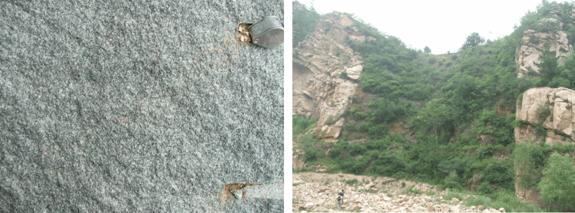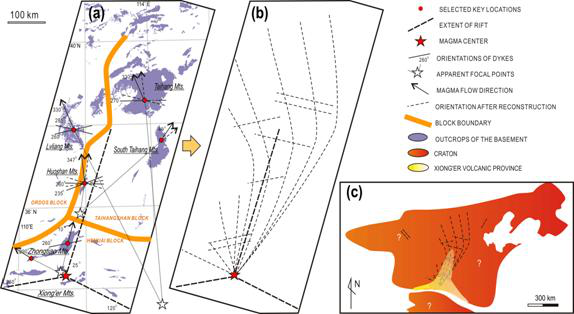April 2009 LIP of the Month
1770-1780 Ma North China Large Igneous Province*
P. Peng
State Key Laboratory of Lithospheric Evolution, Institute of Geology and Geophysics, Chinese Academy of Sciences, Beijing 100029, China; pengpengwj@mail.iggcas.ac.cn
*This is extracted from the following papers:
Peng, P., 2009. Reconstruction and interpretation of giant mafic dyke swarms: a case study of 1.78 Ga magmatism in the North China craton. In: T. Kusky, M. Zhai, W. Xiao (eds.) The Evolving Continents: Understanding Processes of Continental Growth. The Geological Society of London Special Publication, in press.
Peng, P. Zhai, M.-G., Ernst, R. Guo, J.-H., Liu, F. & Hu, B. 2008. A 1.78 Ga Large Igneous Province in the North China craton: The Xiong'er Volcanic Province and the North China dyke swarm. Lithos, 101(3-4), 260-280.
See also: LIP of the Month, June 2005: The Xiong’er Group: A 1.76 Ga Large Igneous Province in East-Central China? By Franco Pirajno, Yanjing Chen
Corresponds to event 141 in LIP record database
The 1770-1780 Ma Taihang-Lvliang dyke swarm has a scale of about 1000 km and is one of the most significant and best-preserved Precambrian swarms in the central part of the North China craton (Fig. 1). It consists of hundreds of NNW trending (315° to 345°) dykes evenly distributed throughout the central North China craton, as well as a few NE (20-40°) and E-W trending (250- 290º) dykes (Fig. 1). It was followed by a younger NNW trending swarm with a distinct composition (the Beitai swarm, 1765 Ma). The dykes are diabase with varied width (up to 100 m, mostly around 15 m) and length (up to 60 km) (Fig. 2).
This swarm is interpreted to have a primary fanning geometry (after correction for local block rotations) that converge on the Xiong’er triple-junction rift, and Xiong’er volcanic province, which is proposed to be the extrusive counterpart to the dykes (Fig. 3a, b). The 1770-1780 Ma Xiong’er volcanic province is located in the south of the North China craton, and has three branches, i.e. two branches along the southern margin of the North China craton and a third one extending northward into the interior of the North China craton (Fig. 1). It has a thickness of 3-7 km and is dominated by thick and continuous lava flows, with rare, thin, sedimentary and volcaniclastic interlayers. It is composed of diabasic and porphyritic rock, and is chemically tholeiitic but widely affected by albitization. The composition varies from basalt, to andesite, dacite, and rhyolite, with andesitic compositions being dominant. It consists of two volcanic cycles, both varying from mafic-intermediate to more silicic compositions; the age gap between the two cycles is not known. There are also some ultramafic bodies in the province, with associated Ni-Cu-(PGE) deposits, which are probably related to the Xiong’er volcanics.
As a whole, the Taihang-Lvliang swarm and the Xiong’er volcanic province are comparable to Phanerozoic Large Igneous Provinces (LIPs) for their large areal extent (~0.3 Mkm2) and estimated volume (~0.3 Mkm3), short lifespan (< 20 Ma), and intra-plate setting. This North China LIP is unique in that it comprises large volumes of both mafic and intermediate components, a result of Fe-Ti-oxides controlling fractionation. This LIP could have originated from extensive mantle-crust interaction, probably driven by a large scale mantle upwelling, which resulted in significant extension, uplift and magmatic addition to the North China craton. A plume tectonic model is favoured by several lines of supporting evidence, i.e. massive volcanic flows correlated over large areas, a giant fanning dyke swarm, and plume-type chemistry in some of the associated volcanic rocks. This LIP could responsible for the regional massive sulphide (Pb-Zn) and gold (Au-Ag) ore deposits in the Xiong’er volcanic province. Identification of dismembered remnants of this dyke swarm/volcanics in other block(s), would reveal which blocks were formerly connected to the North China craton; potential candidates are in South America, Australia and India. (Fig. 3c).

Figure 1: Map showing the distribution of the Taihang-Lvliang dyke swarm and Xiong’er volcanic province in the central North China craton.

Figure 2: Photos showing a rock and an occurrence of a Taihang-Lvliang dyke.

Figure 3: Geometry of the Taihang-Lvliang dyke swarm and Xiong’er volcanic province: (a) orientations of the dykes and apparent magmatic focal point, and the extent of the rifts; (b) presumed geometry of the dykes after reconstruction in relation to the configuration of the rift; (c) suspected configuration model of the North China craton at ca.1.78 Ga.